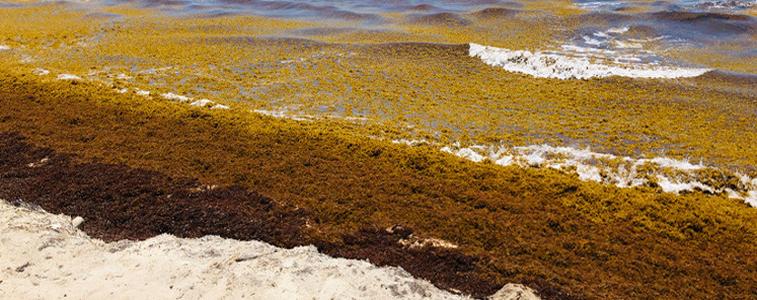 In recent years we have posted about the impact of massive mats of sargassum in the warmer waters of the Gulf of Mexico and the Atlantic. The brown buoyant seaweed has had a devastating impact on beaches across the east coast of Mexico, the Caribbean, Texas, and Florida.
In recent years we have posted about the impact of massive mats of sargassum in the warmer waters of the Gulf of Mexico and the Atlantic. The brown buoyant seaweed has had a devastating impact on beaches across the east coast of Mexico, the Caribbean, Texas, and Florida.
Recent reports are of a new 5,000-mile-wide sargassum bloom targeting Florida, that is so large, it can be seen from space.
The Hill reports that Florida’s Gulf coast is already grappling with red tide, an algae bloom, amid the busy spring break tourism season. Red tide has caused dead fish to wash ashore in droves, while the risk of respiratory irritation for humans has canceled events and driven beachgoers away.
With a blanket of sargassum approaching, spanning twice the width of the continental U.S., scientists warn that Florida beaches could soon be inundated with seaweed.
“It’s incredible,” Brian LaPointe, a research professor at Florida Atlantic University’s Harbor Branch Oceanographic Institute told NBC News. “What we’re seeing in the satellite imagery does not bode well for a clean beach year.”
LaPointe, who has studied the blooms for decades, said beaches in the Florida Keys are already being affected. Earlier this week, parts of Mexico were told to prepare for up to three feet of sargassum to build up on shore.
Southern Ocean Iceberg Threat
At the extreme southern end of the globe there are reports of another sort of floating threat.
The Independent reports that scientists fear that an iceberg the size of Greater London could soon hit shipping, fishing, and wildlife.
Researchers are currently tracking two large icebergs, one named the A81 – the size of Greater London – and one the A76a, which is even larger. The size of Cornwall, the latter has been likened to an ironing board due to its shape.
Long and thin, the A76a iceberg measures over 3,000 sq km, with one research team tracking it aboard the Royal Research Ship Discovery. Inspecting it as it travelled out of Antarctica’s Weddell Sea into the South Atlantic, one biological oceanographer recalls that it took “24 hours” to traverse it on their path home.
The A76a iceberg originated from the Filchner-Ronne Ice Shelf in May 2021, having started off further south of its current position. Heading north, it is now being carried by currents and winds towards the Falklands and South Georgia, posing concern that it could become lodged in the continental shelf’s shallow waters.
It is equally possible that the iceberg could become trapped within a collection of nearby islets known as Shag Rocks, either of which scenarios could wreak havoc for local wildlife and people alike.
Thanks to Alaric Bond for contributing to this post.

Kthanks again